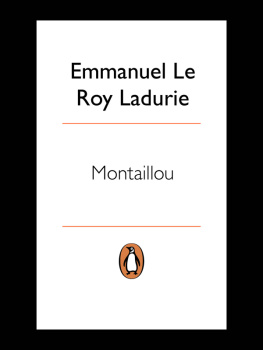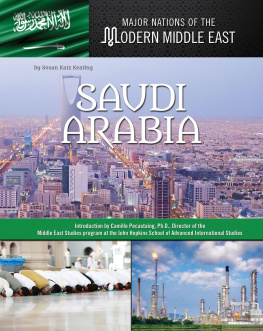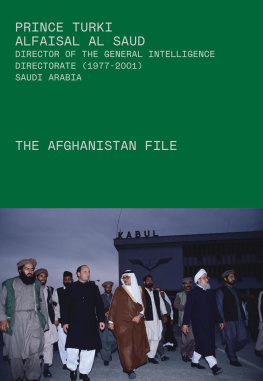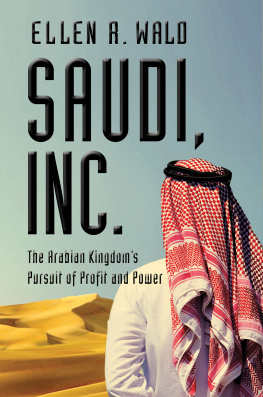IBN SAUD
The Desert Warrior Who Created
the Kingdom of Saudi Arabia
IBN SAUD
The Desert Warrior Who Created
the Kingdom of Saudi Arabia
MICHAEL DARLOW
and
BARBARA BRAY

SKYHORSE PUBLISHING
A Herman Graf Book
Copyright 2010, 2012 by Michael Darlow and Barbara Bray
First published in the UK by Quartet Ltd.
All Rights Reserved. No part of this book may be reproduced in any manner without the express written consent of the publisher, except in the case of brief excerpts in critical reviews or articles. All inquiries should be addressed to Skyhorse Publishing, 307 West 36th Street, 11th Floor, New York, NY 10018.
Skyhorse Publishing books may be purchased in bulk at special discounts for sales promotion, corporate gifts, fund-raising, or educational purposes. Special editions can also be created to specifications. For details, contact the Special Sales Department, Skyhorse Publishing, 307 West 36th Street, 11th Floor, New York, NY 10018 or info@skyhorsepublishing.com.
Skyhorse and Skyhorse Publishing are registered trademarks of Skyhorse
Publishing, Inc., a Delaware corporation.
Visit our website at www.skyhorsepublishing.com
10 9 8 7 6 5 4 3 2 1
Library of Congress Cataloging-in-Publication Data is available on file.
ISBN 978-1-61608-579-7
Printed in the United States of America
Contents
1 Cast Out
January 1891
2 Fugitives in the Land of Their Fathers
From times immemorial to 1891
3 Making of the Man
1891January 15th 1902
4 Shaikh Amid the Imperialists
19021910
5 Shakespear, the Ikhwan and the Coming War
19101914
6 Death of an Englishman
1914 January 1915
7 War and Revolt
19151918
8 Unleashing the Ikhwan
19191923
9 Calif Out
19241926
10 Rebellion
19261929
11 Hard Times and the Coming of the Oil Men
19291934
12 New Ways, New Wars
19341939
13 War and Meetings of Great Men
19391945
14 Riches and the Dying of the Light
19451953
15 Legacy
1953 to the present
Details of many of the key events in the life of Ibn Saud are still disputed. In most instances where a dispute exists we have added an explanatory footnote rather than explaining in the main body of the text.
Spelling, etc
To make life easier for the reader we have tried to be consistent about the spellings and transliterations of Arab names, place names, words and expressions. However, a difficulty remains in that there is no universally agreed system of rendering Arabic names and words into English and writers in English about Arabia seem to adopt different approaches. On top of this, commonly accepted spellings and transliterations of common Arabic words and names seem to vary at different times. For instance, the spelling of Ibn Saud varies depending on who is writing his name and when. Similarly, common spellings for the name of Ibn Sauds father, Abd al-Rahman, include Abdur Rahman and Abdul Rahman. We have adopted Abd al-Rahman because we are assured by native Arabic speakers that it approximates most closely to his name as spoken in Arabic and is the spelling most acceptable among Arabs. A further complication arises from the use by Arabic speakers of familial and patronymic variations of names. We have therefore tried to adopt a single spelling and form of name for each person whenever they appear. However, there is a particular problem over the name of Ibn Saud himself. Ibn Saud only came to be widely referred to by that name after he had become the ruler of Najd. Prior to that various of his forebears had been commonly referred to by the family name Ibn, bin or al Saud. Before becoming ruler of Najd Ibn Saud was known as Abd al-Aziz, with or without the addition of his family name. Most of his Arab contemporaries continued to refer to him as Abd al-Aziz throughout his life. However, in the West once he had become the ruler of Najd he came to be widely and best known as Ibn Saud or bin Saud. So to avoid confusion we refer to him by the name Abd al-Aziz until the time when he became ruler of Najd and thereafter by the name Ibn Saud, the name by which he is now best known, especially in the West. We have clearly indicated in the text the point at which this change in the way he is referred to occurs.
An additional complication arises from the fact that a lot of different people bore the same name for instance Faisal, Faysal or Feisal. In order to make it easier for the reader to distinguish between them we have wherever possible used accepted different spellings for each character so the Saudi Faisal is spelt with an a whereas the Hashemite Feisal is spelt with an e, and so on. For ease of reading we have also included a Cast List, giving the names of all the principal characters (with spellings as they appear in the text), together with a brief description of who each one is.
We have also provided a brief Glossary of the common Arabic and Muslim words that appear in the text.
Maps
Two detailed maps are included as end papers. One is political, and covers Arabia and the region immediately surrounding it, and also shows the location of the principal towns and cities in the story and of major international frontiers as they were towards the end of Ibn Sauds life. The other map shows the main physical features of the Arabian Peninsula together with the grazing areas of the main tribes that feature in the story. There are also smaller sketch maps at the beginning of each chapter showing the places or features relevant to that chapter.
The authors and publishers have made all reasonable efforts to contact the photographers and/or owners of all the pictures reproduced in this book, but in the event of any omissions or errors wish to apologise to the photographers, owners or copyright holders concerned. We are especially grateful to the following for permission to reproduce the photographs listed below:
THE ROYAL GEOGRAPHICAL SOCIETY for the following photographs by Captain Shakespear: Figs..
ST ANTONYS COLLEGE, OXFORD, MIDDLE EAST CENTRE for the following photographs by Gertrude Bell: Figs. by Sir George Rendel.
THE PITT-RIVERS MUSEUM, UNIVERSITY OF OXFORD for permission to reproduce Wilfred Thesigers Interior of The Empty Quarter (PRM 2004.130.12987.1) on the front cover and for Fig. (PRM 2004.130.17416.1).
GETTY IMAGES for the following photographs: Figs..
We wish to thank the DICKSON FAMILY for permission to use the following photographs by the late Harold and Dame Violet Dickson: Figs..
We wish to thank the following photographers and artists for permission to reproduce their work: NOWFAL MOHAMMAD for Fig..
A number of photographs reproduced in the book are either out of copyright, in the public domain or we have been unable to trace a copyright owner or person empowered to issue a reproduction licence. We list those photographs below and the sources from which we have reproduced them. We acknowledge our indebtedness to them all. THE LIBRARY OF CONGRESS in the United States for Fig..
If the work of any photographer or copyright owner is featured in this book for which clearance has not been obtained the authors and publishers would be happy to pay the appropriate licence fee on establishment of such ownership.
This book was the brain child of Naim Attallah. It was he, with his characteristic enthusiasm and patience, allied with his personal knowledge of the Middle East and the Arab world, who overcame our initial lack of confidence over our fitness to take on the task of writing it. Throughout the almost three years of its gestation Naim has remained an unfailing source of advice, knowledge and encouragement. So our first and greatest debt of gratitude is to him. Thank you Naim. It has been fun.
Next page














